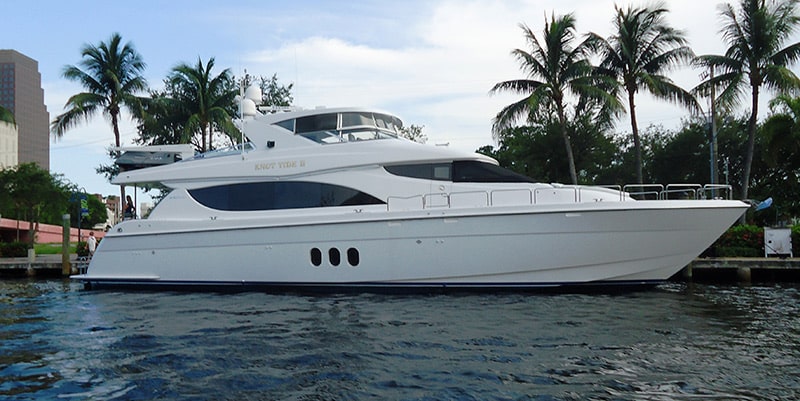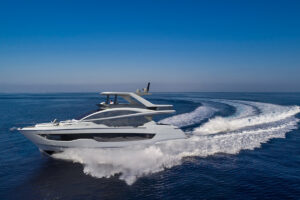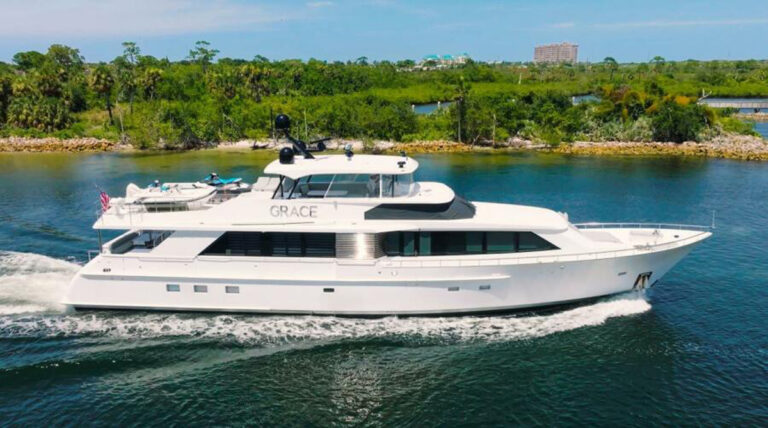
When I first met the Hatteras 80 Motor Yacht, she was a relatively bare hull, deck and cabin. Seven months later, I found myself sitting on her soft leather settee in the full-beam saloon, which spans more than 21 feet, admiring the African mahogany joinery. The reality was well beyond what my imagination conjured on that earlier day, high above the factory floor.
Experiences like that make it a cinch to envision why the employees of Hatteras Yachts are confident of the 80’s potential in the under-100-foot-LOA cruising niche. The 80 is an attractive offering for the discriminating cruising family looking for quality beyond the norm. Though she is large, a small crew can easily handle her. Her 5-foot, 4-inch draft is well suited to Bahamian locales, and her broad beam and ample displacement should prove worthy of more adventurous crossings.
With the optional passerelle, the 80 will be a standout Med-moored beside the Italian entries in her category, both inside and out. Her exterior styling is a departure from Hatteras’ past designs, which relied mightily on Jack Hargrave’s still-popular concept of solidly performing, narrow-beam motoryachts. This new 80-footer is all about beam and the convex hull on which Hatteras Yachts is staking its future.
“When you evolve a hull shape, it is a learning curve”, said Bryant Phillips, senior vice president of sales and marketing at Hatteras Yachts. “Ours began with the 6300, was perfected with the 54 and manifested with the 80. Our evolution had to be a revolution in what we wanted to achieve in high speeds, shallow draft and smooth ride. We wanted a faster, smoother ride from a boat that doesn’t have to substitute substance.”
They succeeded. The sheer vastness of interior volume and stunning décor prompted involuntary and resounding “wows” from many who boarded her. The saloon, master cabin and bridge deck exploit what Hatteras’ 38 full-time in-house engineers provided, most notably a 3-foot increase in beam over that of her 75-foot sibling.
The helm station, forward, made me feel as though I were piloting a sport cruiser, albeit a large one. I ran the 80 from the lower helm station, and the sound levels-66 decibels at cruise-were among the lowest I have tested. At sea, the 80 had a solid and responsive attitude; nothing seemed to faze her. Whether she was idling around the docks, going for long runs at 1200 rpm and 13.2 knots, or hitting a fast cruise of 21 knots at 1800 rpm, this Naiad-stabilized yacht behaved well-the only spray was created by the rotors of the helicopter used for our photo shoot. Our test ride proved displacement and speed could commingle.
The hull has a double chine forward, and her attitude under way parts the bow wake abaft the forward spring cleat. Tunnels travel forward from the transom to the engine pockets, ending near the struts. Sea chests are incorporated into the hull, consolidating raw-water pick-ups and providing a cleaner running surface. As is customary at Hatteras, the 80’s bottom is solid fiberglass, and the sides, deck and house are laminated with Divinycell core. There are four foam-filled longitudinal fiberglass stringers.
Hatteras designed the stand-up machinery space to accommodate the 2,000 hp MTU 16V2000s. Our test boat was outfitted with twin 1,550 hp Caterpillar C30s, and long-range cruisers will find little reason to go larger. Two Onan Electronic Quiet Diesel (EQD) generators, set on aluminum brackets, deliver power through a builder-fabricated state-of-the-art electrical system and panel, which includes thermal magnetic alloy breakers.
The Cats are fed by a day tank and stainless-steel lines, and fuel can be transferred from the mains by a panel at the helm. The system has appropriate safety features. Fuel and water tanks are fiberglass. Wiring is expertly bundled and fastened, and plumbing or electrical runs that travel outside the space are sealed from moisture. Engine access is through a door in the cockpit, which also leads to the crew quarters.
The two crew cabins are spacious, with a galley, dinette and washer/dryer.
The main cabin’s décor is ultimately the owner’s choice, but Hatteras Design gets it right, down to the last throw pillow. From my perspective it seems unwise to stray from the input and direction of the in-house team. The company’s interior designers take full advantage of the nuances the naval architects envisioned from the inception of the project.
In the saloon and staterooms, luxury permeates the new build. Finely crafted mahogany valences spill cool air into the saloon, and decorative marbleized columns boldly make their presence felt. Moldings sport triple bull-nose edging, and plush, made-for-Hatteras carpet cushions bare feet and contributes to sound attenuation. Lutron controls set the proper lighting levels.
Intricate and creative amenities flourish in unlikely places such as the saloon, which has a built-in wine cooler, and the accommodations-level foyer, which has a nook for a coffeemaker and fridge. The day head in the pilothouse is exquisite; doors are crafted with inlays of ebony, while patterned leather walls integrate the décor to the companionway and the soft flowing lines of radius design and rope-accented lighting. All seams in the wall treatment are aligned to a Whisper Wall headliner with exacting precision. Hardware throughout is of weighty construction.
The 80 Motor Yacht has a four-stateroom, four-head layout, and the builder is flexible with configuring cabins. The forward guest stateroom benefits from the convex design; it is a good-size cabin.
The full-beam master stateroom grandly greets the foyer with double doors. Six robust portholes, one an escape exit, allow natural light to bathe the crushed-velvet wallpaper. Stowage under the berth is cedar-lined, and a large locker with twin doors opens wide. All staterooms have full-length mirrors. Controls for temperature and other components, such as the stereo, are tucked from view in lockers, resulting in clean surfaces.
The his-and-her master head is decorated with marble and granite, and the sole has tasteful accents. Heavy-gauge Plexiglas encompasses the shower. All heads had optional Plexiglas overhead treatments, which created a sensation of even greater interior volume. The guest head has a soaking tub.
The galley, too, received the Hatteras touch, as seen in its pegs and fiddles for cook-, flat- and glassware. Special safety features for the microwave and stovetop prevent units from being left on when the concealing cabinetry is secure. The area includes all appropriate appliances. Here, the sole is Amtico; a similar surface is used in the pilothouse.
Owners who choose the lower helm will find it to their liking, though I’d prefer to invest another $300,000 and enclose the flying bridge, since it creates a country kitchen-style galley. Hatteras’ expandable, Ethernet-based PC monitoring system oversees the yacht and can display schematics from supplied CDs, as well. A Simrad digital depth unit and autopilot, an Icom VHF and Northstar 952 are standard. Twin pantograph doors secure the house, and a two-panel windshield opens the world to the captain. Beneath the helm is room for stowage and the large elements of the navigation units.
The crew will enjoy the Hatteras approach to cleat placement, side decks and dockside amenities. Cleat cutouts are large for easy line handling. A bow compartment houses the shore-power cable, and a Maxwell 4000 windlass and chain locker are farther forward. On either side are stowage compartments of adequate size. Grab rails on the house replace deck stanchions, a concept I initially questioned. While under way, however, I stepped from the cockpit to the side decks and felt quite safe all the way to the bow.
The flying-bridge deck is a large enough for a wedding and outfitted with a stereo, a bar and appropriate service items to cater the event. A deck hatch discreetly blends with the sole, covering the stairs from the cockpit, and the hydraulic davit sits athwartships, acting as a barrier to the tender-stowage area. Three pedestal seats are abaft the helm; they could use a few more inches of separation. The ride up top is indoor-quiet, and the view is spectacular. The hideaway wing stations provide clear lines of sight for docking.
It’s true-the sophisticated Hatteras 80 Motor Yacht is a boat without much of a downside, one poised to reach well beyond her North Carolina roots and into positions of global importance. From what I saw, she is already out of this world.
Contact: Hatteras Yachts, (252) 634-4895; www.hatterasyachts.com. For more information, contact: (866) 922-4877; www.yachtingnet.com/yachting/productinfo.









